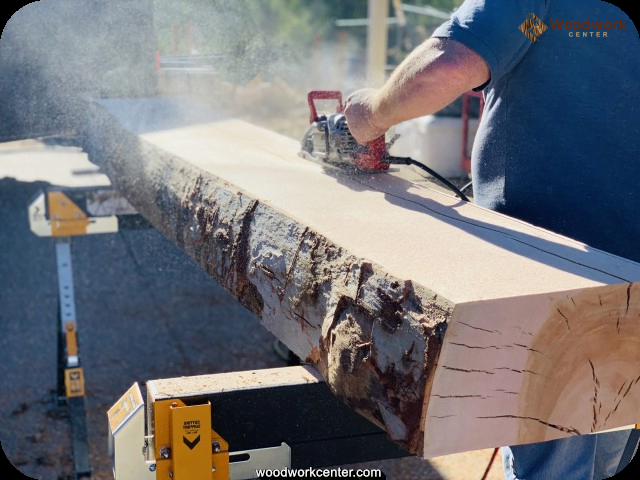Woodworking is not just a hobby or a way to relax after a long week at work. It can also be a profitable venture that allows you to earn money from the comfort of your own home. In this article, we will explore the lucrative opportunity of making money woodworking from home and provide you with all the information you need to get started on this exciting journey.
With the increasing popularity of handmade, unique, and personalized products, there is a growing demand for high-quality woodworking pieces. Whether it’s furniture, home decor items, or custom-made gifts, people are willing to pay a premium for beautifully crafted woodwork. And what better way to capitalize on this trend than to start your own woodworking business from home?
Setting up your home woodworking workshop is the first step towards turning your passion for woodworking into a profitable enterprise. But what tools and equipment do you need? How do you choose profitable woodworking projects? And how do you find affordable and quality wood supplies? These are just some of the questions we will address in this article.
So if you’re ready to embark on an exciting journey that combines your love for working with wood and making money, keep reading. We will guide you through the process of setting up your workshop, choosing profitable projects, mastering woodworking techniques, finding affordable materials, pricing your products, marketing and selling them effectively, building a strong brand, exploring additional income streams in the industry, and managing and scaling your woodworking business for long-term success.
Don’t miss out on this opportunity to turn your passion into profit.
Setting Up Your Home Woodworking Workshop
When it comes to setting up your home woodworking workshop, having the right tools and equipment is essential for success. Whether you are a beginner or an experienced woodworker, having a well-equipped workshop will not only make your work easier but also allow you to take on a wider range of projects. Here are some essential tools and equipment that you should consider including in your woodworking workshop:
Workbench
A sturdy workbench is the foundation of any woodworking workshop. It should be large enough to accommodate your projects and provide a stable surface for working on them. Look for a workbench made of solid wood or steel, as these materials are durable and can withstand heavy use.
Power Tools
Investing in quality power tools is crucial for efficient woodworking. Some essential power tools include a table saw, circular saw, jigsaw, router, drill press, and orbital sander. Make sure to choose reputable brands known for their durability and performance.
Hand Tools
In addition to power tools, having a set of high-quality hand tools is essential for fine woodworking and detail work. This includes chisels, hand planes, coping saws, files, clamps, and measuring tools such as squares and levels.
Safety Equipment
Working with wood involves potential hazards such as flying debris and sharp edges. Therefore, it is crucial to invest in safety equipment such as safety glasses or goggles, ear protection, dust masks, and gloves. Always prioritize safety when working in your woodworking workshop.
Storage Solutions
To keep your tools organized and easily accessible, consider adding storage solutions to your workshop. This can include tool cabinets or chests, wall-mounted tool racks or pegboards, and shelving units for storing materials and supplies.
Remember that while it’s important to have the right tools and equipment, it’s equally essential to learn how to use them safely and effectively. Take the time to familiarize yourself with each tool’s operation and maintenance requirements.
Additionally, consider taking woodworking classes or workshops to enhance your skills and knowledge, as well as seek guidance from experienced woodworkers who can offer valuable advice. By setting up a well-equipped workshop, you will be well on your way to success in your woodworking business.
Choosing Profitable Woodworking Projects
When it comes to making money woodworking from home, one of the key factors for success is choosing profitable woodworking projects. By identifying high-demand products and niche markets, you can ensure that your efforts and resources are focused on creating pieces that not only sell well but also set you apart from the competition.
Researching Market Trends and Demand
To choose profitable woodworking projects, it is important to stay updated with market trends and understand the current demand for certain products. Conducting market research can give you valuable insights into what customers are looking for, what styles are popular, and which products have the potential for high sales.
There are several ways to gather information about market trends and demand. One method is to visit local craft shows, farmers markets, or flea markets to see what types of wooden items are being sold well. Another option is to conduct online research by browsing through woodworking forums, social media groups, or websites dedicated to woodworking enthusiasts.
Identifying Niche Markets
In addition to staying up-to-date with general market trends, identifying niche markets within the woodworking industry can help you narrow down your focus and increase your chances of success. Niche markets are specific segments or customer groups that have unique needs or preferences.
For example, instead of creating generic furniture pieces like chairs or tables, you could specialize in crafting customized wooden furniture for children’s rooms or eco-friendly furniture made from reclaimed wood. By targeting a specific niche market, you can tailor your products and marketing strategies to meet their needs more effectively.
Balancing Passion with Profitability
When selecting profitable woodworking projects, it’s important to strike a balance between pursuing your passion and ensuring profitability. While it’s essential to enjoy what you create, it’s equally crucial to consider if there is a demand for those specific products in the market.
Consider conducting a cost-benefit analysis for each potential project. Calculate the estimated production costs, including materials, labor, and overhead expenses, and compare them to the potential selling price. This will help you determine whether a project is financially viable and if it has the potential to generate a substantial profit.
By choosing profitable woodworking projects that align with market trends, cater to niche markets, and balance passion with profitability, you can increase your chances of success in making money woodworking from home. The next section will delve into mastering woodworking techniques to create unique and marketable pieces.
Crafting and Designing
When it comes to making money woodworking from home, crafting and designing unique pieces is essential for success. In this section, we will explore the importance of mastering woodworking techniques to create marketable products that stand out from the competition.
One of the first steps in mastering woodworking techniques is to have a solid understanding of different joinery methods. Joinery refers to the technique used to join two or more pieces of wood together. Some common joinery methods include dovetail joints, rabbet joints, and mortise and tenon joints. By perfecting these techniques, woodworkers can create strong and durable pieces that are not only visually appealing but also long-lasting.
In addition to joinery techniques, it is important for woodworkers to become skilled at using various woodworking tools. From hand tools like chisels and planes, to power tools like table saws and routers, having a diverse set of tools will allow woodworkers to tackle a wide range of projects. It is important for woodworkers to learn how to properly use these tools in order to ensure safety and produce high-quality work.
To showcase their skills and creativity, woodworkers should focus on creating unique and marketable pieces. This involves thinking outside the box when it comes to design and utilizing different types of woods or incorporating other materials such as metal or glass into their work. By creating one-of-a-kind pieces, woodworkers can attract a niche market that values craftsmanship and uniqueness.
By mastering woodworking techniques and focusing on crafting unique pieces, woodworkers can set themselves apart from the competition and increase their chances of success in making money from home with their woodworking business.
| Woodworking Techniques | Description |
|---|---|
| Joinery Methods | Techniques for joining two or more pieces of wood together, such as dovetail joints and mortise and tenon joints. |
| Woodworking Tools | A wide range of tools that woodworkers should become skilled at using, including hand tools like chisels and power tools like table saws. |
| Crafting Unique Pieces | Focusing on design and utilizing different materials in order to create one-of-a-kind pieces that attract a niche market. |
Materials and Sourcing
One of the key factors in running a successful woodworking business is finding affordable and quality wood supplies. The materials you use significantly impact the cost and quality of your final products. In this section, we will explore some strategies for sourcing wood supplies that are both cost-effective and high-quality.
Research local suppliers
Start by researching local lumber suppliers in your area. These suppliers often offer a wide variety of wood species at competitive prices. Visit their stores or check their websites to see what they have available. Consider reaching out to them to inquire about bulk discounts or special deals.
Look for online options
In addition to local suppliers, there are many online platforms where you can find affordable wood supplies. Websites like eBay, Craigslist, and Facebook Marketplace often have sellers offering discounted or surplus wood. Take advantage of these platforms to find great deals on different types of wood.
Utilize salvage materials
Salvage materials can be a cost-effective option for sourcing wood supplies. Check with local construction sites, renovation projects, or demolition companies to see if they have any salvaged timber that you can purchase at a lower cost or even get for free. Salvage yards and antique stores may also have unique pieces of reclaimed wood that can add character to your projects.
Join woodworking communities
Joining woodworking communities, both online and offline, can be an excellent way to connect with fellow woodworkers who may have recommendations on where to find affordable and quality wood supplies. They can guide you towards trusted sources that offer competitive prices and provide insight into their experience with different suppliers.
Finding affordable and quality wood supplies is essential for running a cost-effective woodworking business without compromising on the overall quality of your products. By utilizing the strategies mentioned above, you can ensure that you have access to the materials needed for successful production. Remember to compare prices, check for deals, and explore different sourcing options to maximize your profitability while maintaining the high standard of your craftsmanship.
Pricing Strategies
Determining the right price point for your woodworking products is crucial to maximize profit and attract customers. Pricing plays a significant role in the success of your business, as it affects both your revenue and customer perception. Here are some strategies to help you set the right prices for your woodworking products.
- Know Your Costs: Before setting a price, it’s important to determine all the costs associated with producing your woodworking products. This includes materials, tools, utilities, labor, packaging, marketing expenses, and overhead costs. Knowing these costs will help you understand the minimum price you need to charge to cover your expenses and make a profit.
- Research the Market: Conduct market research to understand the pricing trends for similar woodworking products in your area or online platforms. Look at competitors’ prices and analyze their product features and quality compared to yours. This will give you an idea of where you stand in terms of pricing and help you position yourself competitively in the market.
- Consider Value Perception: Customers perceive value differently based on factors such as product uniqueness, quality craftsmanship, brand reputation, and customer service. When determining your prices, consider how these elements contribute to the perceived value of your woodworking products. If you offer something that sets you apart from competitors or if you have built a strong brand reputation, you may be able to justify higher prices.
4. Implement Pricing Strategies: There are various pricing strategies that can be utilized depending on your goals and target market. Some common strategies include:
- Cost-Plus Pricing: Adding a markup percentage over your total costs.
- Competitive Pricing: Setting prices similar or slightly lower than competitors.
- Value-Based Pricing: Setting prices based on perceived value rather than cost.
- Penetration Pricing: Offering initial low prices to attract new customers.
- Bundle Pricing: Combining multiple items into a discounted package.
By implementing these strategies and constantly evaluating your pricing strategy based on market changes, customer feedback, and financial goals, you can find the right price point to maximize profit while staying competitive.
Remember, pricing is not a one-time decision. It’s important to regularly review and adjust your prices based on market conditions, cost fluctuations, and customer demand. Continuously monitor your sales data and customer feedback to determine if your prices are effective or if they need adjustment. Finding the right balance between profitability and customer attractiveness is key to long-term success in the woodworking business.
Marketing and Selling Your Woodworking Products
Once you have crafted and designed your woodworking products, the next step is to market and sell them effectively. The success of your business depends on reaching potential customers and generating sales. In this section, we will explore some effective online and offline strategies that can help you generate sales for your woodworking products.
When it comes to online marketing, having a strong online presence is crucial. Start by creating a professional website that showcases your woodworking products with high-quality images and detailed descriptions. Make sure your website is user-friendly and optimized for search engines so that potential customers can easily find you when they search for relevant keywords.
In addition to a website, consider utilizing social media platforms such as Instagram and Pinterest to showcase your woodworking products. These platforms are visually oriented and can help you reach a wider audience. Use hashtags related to woodworking, home decor, or DIY projects to increase visibility and engage with potential customers.
Offline strategies are equally important in selling your woodworking products. Participate in local craft fairs, farmer’s markets, or artisan markets where you can set up a booth to display and sell your products directly to customers. Networking with other artisans at these events can also lead to collaborative opportunities or referrals.
Another offline strategy is establishing partnerships with local retailers or interior designers who may be interested in carrying your woodworking products. Approach them with samples of your work along with a wholesale pricing structure that provides enough margin for both parties involved.
By combining effective online and offline marketing strategies, you can increase the visibility of your woodworking business, attract more customers, and ultimately generate more sales. Remember to regularly evaluate the success of each strategy and make adjustments as needed to maximize the results.
| Online Marketing Strategies | Offline Marketing Strategies |
|---|---|
| Create a professional website | Participate in local craft fairs |
| Utilize social media platforms like Instagram and Pinterest | Establish partnerships with retailers and interior designers |
| Optimize website for search engines | Network with other artisans at events |
Building a Strong Brand
Building a strong brand is essential for any woodworking business looking to establish a recognizable and trustworthy identity. A strong brand not only helps differentiate your products from competitors, but it also builds customer loyalty and attracts new customers. In this section, we will discuss some key strategies for building a strong brand in the woodworking industry.
One important aspect of building a strong brand is developing a distinct visual identity. This includes creating a logo and choosing consistent colors, fonts, and visual elements that reflect the personality of your woodworking business. Your logo should be memorable and versatile so that it can be easily recognized across different platforms and mediums.
Another crucial element in establishing a recognizable brand is defining your unique selling proposition (USP). What makes your woodworking business stand out? Is it the quality of your craftsmanship, the use of sustainable materials, or the customizability of your products? Identify what sets you apart from others in the industry and use that as a foundation for your brand messaging.
Consistency is key when it comes to building a strong brand. Ensure that all aspects of your business, from your website and social media presence to packaging and customer service, align with your brand values and messaging. By providing a consistent experience across all touchpoints, you create trust with customers and reinforce the reliability of your brand.
Expanding Opportunities
In addition to creating and selling unique woodworking pieces, there are several other income streams that woodworkers can explore to maximize their earning potential. These additional opportunities can help diversify your business and create multiple revenue streams. Let’s explore some of these options:
- Woodworking Classes: Consider offering woodworking classes or workshops where you can teach others the skills and techniques of woodworking. Many people are eager to learn this craft, and by sharing your knowledge and expertise, you can generate an additional stream of income. You can offer classes on a variety of topics such as basic woodworking skills, advanced techniques, specific projects, or even specialized workshops like woodturning or carving.
- Custom Orders: Alongside creating your own unique pieces for sale, you can also take custom orders from clients who have specific requirements or design ideas. Custom orders allow you to tailor your work directly to the customer’s desires, resulting in higher prices and potentially larger profit margins. This could involve creating custom furniture pieces, bespoke cabinets, personalized home decor items, or any other woodworking project based on clients’ requests.
- Woodworking Supplies: Another way to generate additional income is by selling woodworking supplies and materials. As a woodworker yourself, you likely have connections with suppliers in the industry and can source quality products at wholesale prices. By offering these supplies for sale to fellow woodworkers or hobbyists, you can earn money through commissions or markups on the products sold.
- Repairs and Restorations: Many people have valuable wooden furniture or antique pieces that need restoration or repair work. Leveraging your knowledge of woodworking techniques and craftsmanship, you can offer services for repairing broken furniture legs, refinishing worn-out surfaces, fixing damaged joints, or simply restoring old pieces back to their former glory.
- Affiliate Marketing: If you have built a strong online presence through a blog, website, or social media platforms, you can explore affiliate marketing as an additional income stream. By partnering with companies that sell woodworking tools, materials, or related products and promoting their items to your audience, you can earn commissions on any sales generated through your referral links.
By considering these additional income streams in the woodworking industry, you can diversify your revenue sources and increase your earning potential. It is important to research and evaluate which opportunities align best with your skills, interests, and target market. As with any business venture, careful planning and execution are key to ensuring success in exploring these additional income avenues in the woodworking industry.
Managing and Scaling your Woodworking Business
In conclusion, managing and scaling your woodworking business is crucial for achieving long-term success and growth in this industry. By implementing the right tips and strategies, you can maximize your profit potential and take your woodworking business to new heights.
One important aspect of managing your woodworking business is having strong organizational skills. It’s essential to keep track of your inventory, expenses, and customer orders to ensure smooth operation and timely deliveries. Investing in a good record-keeping system or software can be beneficial in streamlining these processes.
Another key tip for scaling your woodworking business is to build a reliable network of suppliers. Finding reputable suppliers who offer quality wood materials at affordable prices will help you maintain cost-effective production. You should also consider establishing relationships with other businesses or artisans who can provide complementary products or services, creating mutually beneficial partnerships.
Additionally, continuously seeking feedback from customers can greatly contribute to the growth of your woodworking business. Understanding their preferences and satisfaction levels will allow you to refine your products and services accordingly. This can be done through customer surveys, reviews on online platforms, or direct communication channels.
As you expand your woodworking business, it’s also important to evaluate outsourcing certain tasks if needed. Outsourcing can help increase efficiency and productivity by allowing you to focus on core aspects of the business such as design and production. However, it’s crucial to carefully vet potential outsourcing partners to ensure they meet quality standards and align with your brand values.
Lastly, never stop learning and improving your craft. Stay updated with the latest trends in woodworking techniques, designs, and marketing strategies that can help set you apart from competitors. Joining relevant industry associations or attending trade shows can provide valuable insights into market trends while also giving you opportunities to network with like-minded professionals.
Overall, with dedication, creativity, strategic planning, effective management strategies, and continuous improvement efforts, you can successfully manage and scale your woodworking business for long-term success in this lucrative industry.
Frequently Asked Questions
Is woodworking a good way to make money?
Woodworking can be a good way to make money, but it largely depends on various factors such as skill level, market demand, and business strategies. Skilled woodworkers who are able to create high-quality and unique pieces have the potential to earn a decent income from selling their products.
However, it is important to consider the costs involved in terms of materials, tools, and overhead expenses. Additionally, establishing a strong customer base and marketing your products effectively play a crucial role in ensuring profitability in the woodworking business.
What woodworking project is most profitable?
The profitability of woodworking projects can vary greatly depending on the target market, current trends, and individual preferences. However, there are some general categories that tend to be more profitable than others. Fine furniture pieces like custom dining tables or bed frames often command higher prices due to their craftsmanship and quality materials used.
Other profitable projects include handmade kitchen cabinets or custom built-ins that require skilled craftsmanship and offer functional value. Ultimately, the most profitable woodworking project will depend on finding a niche market that values the unique qualities of your work and is willing to pay a premium for it.
What woodworking items sell the best?
Certain woodworking items tend to sell better than others due to their practicality or aesthetic appeal. Small wooden home decor items such as cutting boards, coasters, or decorative boxes are popular choices among buyers as they are not only functional but also add an elegant touch to interior spaces. Additionally, items like wooden toys or puzzles for children often sell well due to their nostalgic appeal and durability compared to mass-produced plastic alternatives.
Outdoor furniture pieces like garden benches or Adirondack chairs are also sought after by customers who appreciate handcrafted items designed for relaxation in natural settings. In summary, woodworking items that combine functionality with visual appeal tend to sell best in the marketplace.

Hi everyone! I’m a woodworker and blogger, and this is my woodworking blog. In my blog, I share tips and tricks for woodworkers of all skill levels, as well as project ideas that you can try yourself.





